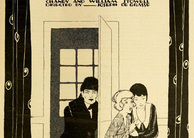Food, Love and Death in Norman's 'night Mother
By
2012, Vol. 4 No. 06 | pg. 2/2 | « The character Martha Klein of Sandra Nettlebeck’s film Mostly Martha (2001) provides a useful comparison for analyzing Jessie’s relationship to food. Martha is a famous German chef who is compulsive about the way she approaches her job and her eating habits and who doesn’t have successful personal relationships. James R. Keller in his book Food, Film and Culture (2006) says of Martha: “The preparation of food allows her to remain aloof from the communal rituals of consumption. When she cooks, she is not then obliged to sit down with others and enjoy it in an environment of social equity and harmony” (69). Jessie also uses the preparation of food to excuse herself from having to consume it. She spends all her time obtaining food for Thelma instead of enjoying it herself. Martha’s trouble with relationships is shown by her attempts to replace actual companionship with an exchange of food. She wants to initiate a friendships with her next door neighbor, but instead offers to cook for him, “a relationship with which she is more comfortable” (Keller 70). When the great tragedy of the film occurs and Martha’s sister Christin dies in a car accident and leaves Martha’s niece orphaned, Martha is forced to take on a motherly role. “[She] naively assumes that the provision of shelter and nourishment is the only requisite for child-rearing,” much in the same way Jessie attempts to create a healthy relationship with Thelma just by feeding her (Keller 72). This replacement of food for real interaction fails just as much for Martha and Jessie as it does for Thelma, although each is attempting this substitution in a different way. The difference between Martha and Jessie stems from the conclusion of each story. Martha learns that her attempts to create happiness with food and rituals are misguided and she chooses to embrace her position as a mother and eventually as a romantic partner for another chef at her restaurant. Jessie moves in the opposite direction. She seems to already have discounted companionship with others, since her relationships with her husband and son have proved to be unsuccessful, and her relationship with her mother doesn’t go much deeper than the procurement of food. As Keller claims, “Martha needs someone on whom to focus other than herself, someone the serve out of love rather than duty or ritual” (71). This is what Jessie needs too, but what she does for Thelma is motivated by her desire to create the feeling of love, rather than by a preexisting and genuine love for her mother. Martha and her niece both refuse to eat after the death of Christin, just as Jessie refuses to eat throughout the entire play. Keller explains that “both women react to loneliness and depression by refusing sustenance” (71). Jessie refusal to eat also has reactive motivations. The text suggests that she wasn’t always opposed to the consumption of food. She describes seeing a picture of herself as a child, saying, “It was somebody else, not me. It was somebody who cried and got fed, who reached up and got held and kicked but didn’t hurt anybody, and slept whenever she wanted to, just by closing her eyes” (Norman 50). Before her husband left her and before her son became a criminal, even, perhaps, before she began having seizures, Jessie enjoyed food, but once she started experiencing tragedy in her life, she began to lose her appetite. To repeat Burkman’s assertion: “[Jessie] lacks the appetite for the choice [to live].” Thelma tells Jessie, “If you’ve got the guts to kill yourself, Jessie, you’ve got the guts to stay alive.” To which Jessie replies, “I know that. So it’s really just a matter of where I’d rather be” (Norman 49). Jessie has no more an appetite for the life she’s wound up with, without her husband or her son, stuck living in her mother’s house, than she does for the hot chocolate with too much milk.While Jessie refuses all foods, neither of the women eats nutritious items. This is most clearly shown in the same hot chocolate scene. Mama: God, this milk in here. Burkman asserts that this scene shows Thelma’s progression to understanding Jessie’s choice: “When Mama tells Jessie she doesn’t need to finish it, she might be talking about Jessie’s life, which Jessie has decided not to finish. Perhaps it is this shared and symbolic distaste for milk that helps Mama finally accept and understand Jessie’s decision.” Although Thelma says the drink is a waste of chocolate, what she has come to understand is the fallacy of her substitution of food for life and for love. As Keller says of another food-disordered character, Joseph Hilditch from Felicia’s Journey who cooks incessantly in memory of his late mother, “The preparation and consumption of food becomes a ritualistic effort to fill the emptiness left by the absent father and the distant mother” (81). Both Jessie and Thelma understand this drive to fill the void. For Thelma, the emptiness is caused by a husband who wouldn’t speak to her and who she didn’t love. For Jessie, it is her family’s destruction and her failure to find a love for anything besides smoking. The shared rejection of the nutrient-packed milk of the hot chocolate and the realization that she doesn’t really have anything to sustain her life any more than Jessie does, is what leads to Thelma’s painful understanding of Jessie’s need to commit suicide. Food themes also illuminate the inverted mother-daughter relationships in the play. Thelma acts like a child. She eats only candy and does none of the chores herself. Rarely, is she seen doing anything mother-like for Jessie. “Mama’s dislike of milk reflects her rejection of the unadulterated and healthful and perhaps also suggests her dissatisfaction with motherhood, which has proven no more rewarding than marriage. Both childish and childlike, Mama prefers surface to substance; she seeks immediate pleasure without concern for the long-term impact of her choice in menu or mate” (Morrow). Jessie has filled the void of mother in their household. She provides for the home and indulges Thelma’s bad habits. Even in the analysis of advertising provided by Parkin, these practices are usually aimed at the mother of the house. Jessie pesters Thelma about eating well and keeping up the house after her death, asking, “Are you going to drink ketchup from the bottle or what? How can you want your food and not want your pots to cook it in? This stuff will all spoil in here, Mother” (Norman 37). Burkman sees Jessie’s role as mother presented through her choice to tell Thelma about her plan to kill herself: “What distinguishes Jessie . . . is her reaching out to her mother in her last hours of life, recognizing her mother’s greater appetite for life, arranging for the continued availability of the sweets her mother craves as a consolation for her empty existence, but also offering her the more nourishing truths that may sustain her after her daughter’s death.” Jessie provides for Thelma like a mother, and is also the biological mother of Ricky, but even though she has these two people to support, she finds them insufficient to require the continuation of her life. Thelma’s accepts Jessie’s treatment of her as a child, and even has come to rely on it. “Jessie, how can I live here without you?” she wails when she begins to realize there’s nothing she can do to stop Jessie’s suicide. I need you! You’re supposed to tell me to stand up straight and say how nice I look in my pink dress and drink my milk. You’re supposed to go around and lock up so I know we’re safe for the night, and when I wake up you’re supposed to be out there making the coffee and watching me get older every day and you’re supposed to help me die when the time comes. I can’t do that by myself, Jessie. (Norman 48). Thelma chooses to act like a child because she doesn’t believe she’s a good mother. She begins to blame herself for Jessie’s dissatisfaction with life. “Maybe I fed you the wrong thing. Maybe you had a fever sometime and I didn’t know it soon enough. Maybe it’s a punishment . . . Because of how I felt about your father. Because I didn’t want any more children. Because I smoked too much or didn’t eat right when I was carrying you. It has to be something I did” (Norman 47). Thelma fears she fed Jessie poorly when she was younger or that she ate something wrong while pregnant, and therefore, she no longer provides Jessie with food or even prepares her own, allowing instead Jessie to fill the mother role she much better suited for. Food is a dramatic tool that Norman uses to its full effect. Her characters are brought together, pulled apart, and defined by their relationships to food. As Poole says, “Through food, women negotiate . . . their lives’ major rites of passage and struggles for autonomy” (181). Most importantly it is through their consumption and preparation of food that these characters attempt to create love, the main ingredient missing from their kitchen. ReferencesBurkman, Katherine H. “The Demeter Myth and Doubling in Marsha Norman’s ‘night Mother.” Modern American Drama: The Female Canon. Ed. June Schlueter. Madison, N.J.: Fairleigh Dickinson Univeristy Press, 1990. Contemporary Literary Criticism. Ed. Tom Burns and Jeffery W. Hunter. Vol. 186. Detroit: Gale, 2004. From Literary Resource Center. Web. Keller, James R. Food, Film, and Culture: A Genre Study. Jefferson, N.C.: McFarland & Company, Inc., 2006. Print. Morrow, Laura. “Orality and Identity in ‘night Mother and Crimes of the Heart.” Studies in American Drama, 1945-Present 3 (1988): 23-39. Contemporary Literary Criticism. Vol. 255 Detroit: Gale. From Literature Resource Center. Web. Norman, Marsha. ‘night Mother. New York: Dramatists Play Service, Inc., 1983. Print. Parkin, Katherine J. Food is Love: Food Advertising and Gender Roles in Modern America. Philadelphia: University of Pennsylvania Press, 2006. Print. Poole, Gaye. Reel Meals, Set Meals: Food in film and theatre. Sydney: Currency Press, 1999. Print. Suggested Reading from Inquiries Journal
Inquiries Journal provides undergraduate and graduate students around the world a platform for the wide dissemination of academic work over a range of core disciplines. Representing the work of students from hundreds of institutions around the globe, Inquiries Journal's large database of academic articles is completely free. Learn more | Blog | Submit Latest in Theatre |










